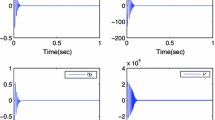Abstract
In many applied control problems in economics, ecology, demography, and other areas, the relationship between dependent and independent main variables is determined statistically, which does not guarantee the smoothness of the model functional dependence. Particularly, in economic growth models, the production function describing the dependence of the output on the production factors is commonly supposed to be everywhere smooth; however, because of this constraint, qualitative parameters affecting the output cannot be included in the model. We propose an approach overcoming the requirement for the production function to be everywhere differentiable. The method is based on a smooth approximation to the production function, which is constructed simultaneously with the integration of the Hamiltonian system. A differentiable approximation to the production function is derived by constructing an asymptotic state observer for an auxiliary system. It should be noted that the standard approach to the approximation of nonsmooth components of the model on a finite time interval may not work here, which necessitates stabilizing the Hamiltonian system on an infinite time interval. The theoretical results are supported by numerical experiments for the one-sector economic growth model.



Similar content being viewed by others
REFERENCES
Aivazyan, S.A., Metody ekonometriki (Methods of Econometrics), Moscow: Magistr: INFRA-M, 2010.
Aseev, S.M., A method of smooth approximation in the theory of necessary optimality conditions for differential inclusions, Izv. Math., 1997, vol. 61, no. 2, pp. 235–258.
Aseev, S.M. and Kryazhimskii, A.V., The Pontryagin maximum principle and problems of optimal economic growth, Proc. Steklov Inst. Math., 2007, vol. 257, pp. 1–255.
Egorov, A.I., Osnovy teorii upravleniya (Foundations of Control Theory), Moscow: Fizmatlit, 2004.
Krasovskii, A.A. and Taras’ev, A.M., Dynamic optimization of investments in the economic growth models, Autom. Remote Control, 2007, vol. 68, no. 10, pp. 1765–1777.
Krasovskii, A.A. and Taras’ev, A.M., Properties of Hamiltonian systems in the Pontryagin’s maximum principle for economic growth problems, Proc. Steklov Inst. Math., 2008, vol. 262, pp. 121–138.
Kurzhanskii, A.B., Upravlenie i nablyudenie v usloviyakh neopredelennosti (Control and Observation under Uncertainty), Moscow: Nauka, 1977.
Pontryagin, L.S., Boltyanskii, V.G., Gamkrelidze, R.V., and Mishchenko, E.F., Matematicheskaya teoriya optimal’nykh protsessov (Mathematical Theory of Optimal Processes), Moscow: Nauka, 1983.
Tarasyev, A.M. and Usova, A.A., Construction of a regulator for the Hamiltonian system in a two-sector economic growth model, Proc. Steklov Inst. Math., 2010, vol. 271, pp. 265–285.
Tarasyev, A.M. and Usova, A.A., Stabilizing the Hamiltonian system for constructing optimal trajectories, Proc. Steklov Inst. Math., 2012, vol. 277, pp. 248–265.
Timan, A.F., Teoriya priblizheniya funktsii deistvitel’nogo peremennogo (Theory of Approximation of Functions of a Real Variable), Moscow: Fizmatlit, 1960.
Ane, B.K., Tarasyev, A.M., and Watanabe, C., Construction of nonlinear stabilizer for trajectories of economic growth, J. Optim. Theory Appl., 2007, vol. 134, no. 2, pp. 303–320.
Arrow, K.J., Production and Capital. Collected Papers. Vol. 5 , Cambridge, MA–London: Belknap Harvard Univ., 1985.
Ayres, R., Krasovskii, A.A., and Tarasyev, A.M., Nonlinear stabilizers of economic growth under exhausting energy resources, Proc. IFAC CAO’09 (2009), pp. 251–256.
Crespo Cuaresma, J., Palokangas, T., and Tarasyev, A., Dynamic Systems, Economic Growth, and the Environment, Berlin–Heidelberg: Springer, 2010.
Crespo, CuaresmaJ., Palokangas, T., and Tarasyev, A., Green Growth and Sustainable Development, Berlin-Heidelberg: Springer, 2013.
Efimov, D., Polyakov, A., Levant, A., and Perruquetti, W., Convergence acceleration for observers by gain commutation, Int. J. Control, 2017, pp. 1–20.
Grossman, G.M. and Helpman, E., Innovation and Growth in the Global Economy, Cambridge, MA–London: MIT Press, 1991.
Intriligator, M.D., Mathematical Optimization and Economic Theory, Classics Appl. Math., Philadelphia: SIAM, 2002.
Kautsky, J., Nichols, N.K., and Van Dooren, P., Robust pole assignment in linear state feedback, Int. J. Control, 1985, vol. 41, pp. 1129–1155.
Khalil, H.K., Nonlinear Systems (3rd Ed.), Upper Saddle River, NJ: Prentice Hall, 2002.
Krasovskii, A.A., Kryazhimskiy, A.V., and Tarasyev, A.M., Optimal control design in models of economic growth, Evolutionary Methods for Design, Optimization and Control (Barcelona: CIMNE, 2008), pp. 70–75.
Krasovskii, A. and Tarasyev, A., Conjugation of Hamiltonian systems in optimal control problems, Proc. 17th IFAC World Congr., 2008, vol. 17, no. 1, pp. 7784–7789.
Shell, K., Applications of Pontryagin maximum principle to economics, Math. Syst. Theory Econ., 1969, no. 1, pp. 241–292.
Solow, R.M., Growth Theory: An Exposition, New York: Oxford Univ. Press, 1970.
Tarasyev, A.M. and Usova, A.A., An iterative direct-backward procedure for construction of optimal trajectories in control problems with infinite horizon, Proc. 18th IFAC World Congr., 2011, vol. 18.
Tarasyev, A.M. and Usova, A.A., Structure of the Jacobian in economic growth models, Proc. the 16th IFAC Workshop CAO, 2015, vol. 48, no. 25, pp. 191–196.
Tarasyev, A.M. and Watanabe, C., Optimal dynamics of innovation in models of economic growth, J. Optim. Theory Appl., 2001, vol. 108, no. 1, pp. 175–207.
Funding
This work was supported by the Russian Science Foundation, project no. 19-11-00105.
Author information
Authors and Affiliations
Corresponding authors
Additional information
Translated by V. Potapchouck
Rights and permissions
About this article
Cite this article
Tarasyev, A.M., Usova, A.A. Estimate of a Smooth Approximation to the Production Function for Integrating Hamiltonian Systems. Autom Remote Control 82, 911–925 (2021). https://doi.org/10.1134/S0005117921050143
Received:
Revised:
Accepted:
Published:
Issue Date:
DOI: https://doi.org/10.1134/S0005117921050143




